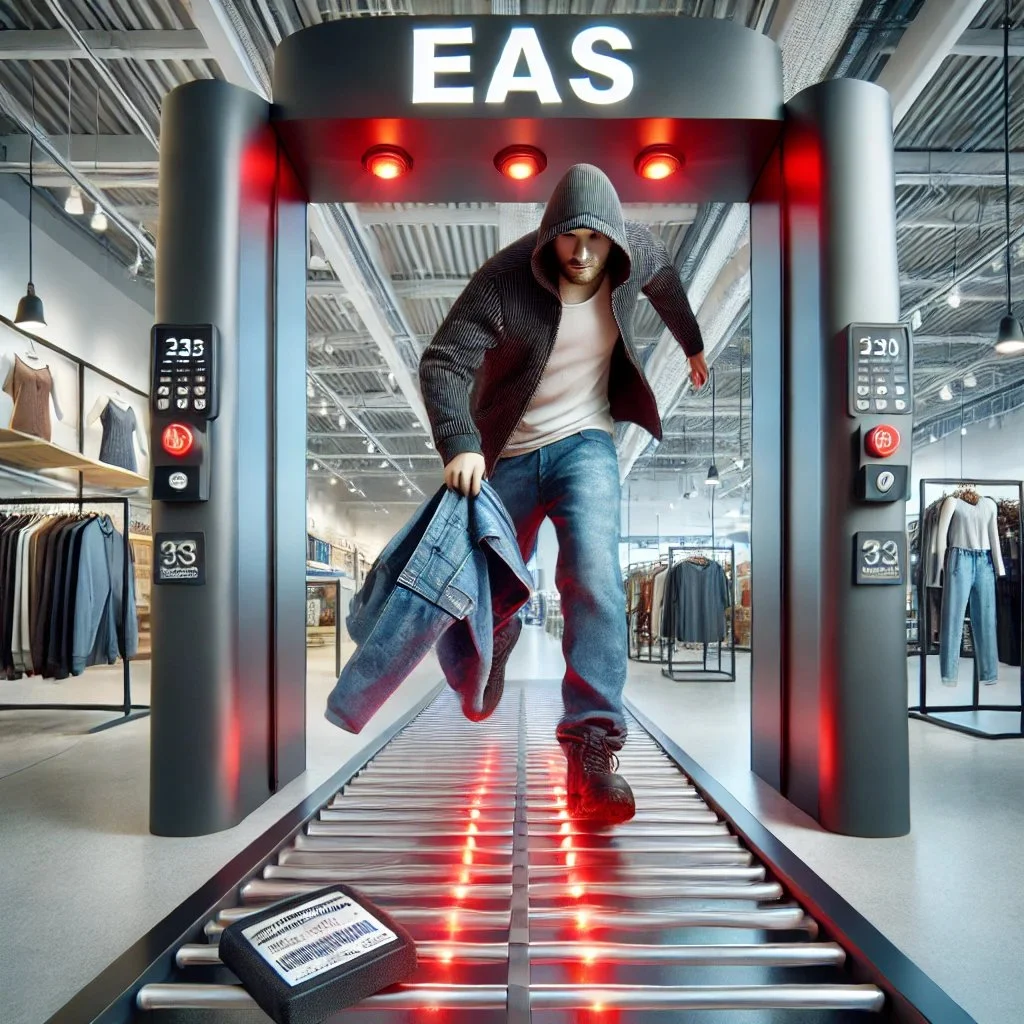EAS systems function by detecting special tags or labels attached to merchandise. Pedestals installed at store exits act as antennas that trigger an alarm if a tag passes through without being deactivated or removed. The effectiveness of these systems is highly dependent on several factors, including pedestal placement, electrical setup, and conduit installation. Ignoring these details can compromise the system’s ability to protect store inventory.
Steve Jacobs
The Hidden Costs of Introducing SuperTag 4: A Closer Look at the Negative Impact on Retailers Requiring New Detachers
There’s no doubt that advanced tags like the SuperTag 4 provide significant advantages in loss prevention, especially in tackling organized retail crime and high-value merchandise theft. However, retailers must carefully consider the hidden costs and operational challenges of upgrading to a system that requires new detachers. The initial financial investment, operational disruptions, and long-term impacts on both staff and customer experiences should be weighed against the potential security benefits.
Case Study: Battling Philadelphia’s Retail Theft Surge – A Bold Policy Response
Philadelphia's experience highlights the delicate balance between criminal justice reform and maintaining public safety. The city's evolving approach to retail theft demonstrates the need for adaptive policies that address both the symptoms and root causes of crime while maintaining a strong deterrent against illegal activities.
Ink Tags: The Game-Changer in Retail Loss Prevention
Ink tags operate on a simple principle: benefit denial. If a thief attempts to forcibly remove the tag, ink vials inside rupture, permanently staining the item. For legitimate customers, the tags are easily removed at the point of sale using a special detacher.
https://losspreventionmedia.com/the-improbable-history-of-the-ink-tag/
The Rise of Anti-Wardrobing Tags: How Retailers Are Combating Return Fraud
Wardrobing is not just a minor inconvenience for retailers; it’s a costly problem. When customers return worn items, these items often cannot be resold at full price and may need to be heavily discounted or even discarded. This leads to lost revenue, increased handling costs, and a negative impact on inventory management.
By implementing anti-wardrobing tags, retailers can significantly reduce the incidence of fraudulent returns. These tags serve as a powerful deterrent, making it clear to customers that wardrobing is not an option. This not only protects the retailer’s bottom line but also helps maintain the integrity of their return policies.
The Dark Side of Self-Checkout: How Convenience Fuels Shoplifting
One of the often-overlooked aspects of self-checkout that contributes to increased theft is the difficulty in effectively using security tags. In traditional checkout lanes, cashiers are responsible for removing or deactivating security tags on items before they leave the store. However, in a self-checkout environment, this process becomes more challenging.
California’s New Laws: Shoplifters Now Face Harsher Consequences
What is clear is that California is taking a stronger stance against shoplifting, with more severe consequences now in place for those who engage in this type of crime. As the state navigates this complex issue, the effectiveness of these new laws will ultimately be measured by their impact on reducing retail theft and ensuring public safety.
https://calmatters.org/justice/2024/08/retail-theft-new-laws/
The Hidden Cost of Locked Cabinets: How Shoplifting Deterrents Are Driving Customers Away
Security TagsSecurity tags can be easily integrated into a wide range of products, from razors to electronics, and they provide a visible deterrent that discourages shoplifters. Unlike locked cabinets, which require employee intervention, EAS systems operate seamlessly in the background, allowing store associates to focus on providing better customer service rather than constantly unlocking cabinets.
https://www.axios.com/2024/08/11/retail-theft-cvs-walgreens-locked-cabinet
Inflation May Be Cooling, But Shoplifting Is on the Rise
Security Tagsover 20% of Americans admitted to shoplifting in the past year, with 90% citing inflation and economic pressures as their main motivation.
https://www.cbsnews.com/amp/news/shoplifting-retail-theft-crime-stealing-inflation/
Training Retail Store Employees in Asset Protection and Loss Prevention
Shoplifter Exiting Through EAS System…
Retail theft and loss can significantly impact a store's profitability. Effective training in asset protection and loss prevention is crucial for employees to safeguard merchandise and ensure a secure shopping environment. Here's a comprehensive guide to training retail store employees in these essential areas.
Understanding the Basics of Asset Protection and Loss Prevention
The first step in training is to help employees understand what asset protection and loss prevention entail. Asset protection refers to the proactive measures taken to safeguard company assets from theft, fraud, and other risks. Loss prevention focuses specifically on preventing theft and reducing losses due to shoplifting, employee theft, and administrative errors.
Key Topics to Cover in Training Sessions
Types of Theft: Educate employees on the various forms of theft, including shoplifting, employee theft, and vendor fraud. Understanding the different types can help employees spot potential threats more effectively.
Recognizing Suspicious Behavior: Training should include how to identify suspicious behavior in customers and fellow employees. This can range from nervousness, avoiding eye contact, or lingering in certain areas without buying anything.
Proper Surveillance Techniques: Employees should learn how to use and monitor security cameras and other surveillance equipment. They should also be trained in the layout of the store to recognize blind spots and vulnerable areas.
Effective Communication Skills: Train employees on how to approach and interact with someone they suspect of theft in a manner that is non-confrontational but firm. Role-playing scenarios can be very effective here.
Emergency Procedures and Reporting: Ensure all staff are familiar with the procedures for reporting suspicious activity or incidents of theft. This includes knowing who to contact, how to document incidents, and the importance of timely reporting.
Legal Compliance: It’s crucial that training includes information on the legal aspects of detaining suspects, handling stolen goods, and respecting the rights of customers and employees.
Interactive and Ongoing Training Approaches
Role-Playing Scenarios: Conduct simulations of various theft situations to help employees practice their responses. This can help build confidence and improve their ability to handle real situations.
Regular Updates: As theft techniques evolve, so should your training programs. Keep training sessions regular and updated with the latest information and best practices.
Use of Technology: Incorporate technology like digital training modules and virtual reality simulations to make learning more engaging and realistic.
Feedback and Assessment: Provide feedback to employees after training sessions and assess their knowledge through quizzes or practical tests.
Creating a Culture of Prevention
Training should also focus on building a workplace culture that prioritizes loss prevention. Encourage employees to take ownership of their roles in asset protection by recognizing and rewarding diligent behavior. Promote teamwork and communication as key components of a successful loss prevention strategy.
Conclusion
Well-trained employees are the first line of defense against retail loss. By providing comprehensive training in asset protection and loss prevention, retailers can not only minimize losses but also promote a safe and secure environment for both staff and customers. Remember, an effective training program is an ongoing process that evolves with new challenges and technologies.
The Growing Concern of Shoplifting: A Closer Look at Today's Retail Challenge
In response to the growing issue of shoplifting, retailers and law enforcement agencies are ramping up their efforts to combat this trend. From investing in advanced surveillance technologies and security measures, like ink security tags, to collaborating on initiatives aimed at dismantling ORC networks…
Which security pins match which security tags?
There are many different styles and types of retail security tags. In this post we will be exclusively talking about hard security tags and the pins that connect to them. Soft tags, security labels, or stickers do not use pins and thus are not relevant to this discussion.
The locking mechanism inside the hard security tag determines the type of pin required. Most but not all magnetic locking security tags can accept a standard flat head pin. Some exceptions are listed below. Supertags and Gator tags both use mechanical detachers and are not able to accept a standard flat head pin. Supertags use Supertag specific pins as do Gator tags. Almost all tags, both mechanical and magnetic, can accept universal ink pins.
Hard Tags that are compatible with standard flat head pins. (Not every style is listed)
Black Mini Hard Tag - TAG1001
Flat Pencil Tag - TAG2064
Stylus Tag Mini White - TAG2045
Stylus Tag Mini Black - TAG2041
Magnetic Bubble Backer - MAG1001
Hawkeye Ink Tag - TAG3003-A
Lingerie Security Tag - TAG2085
Stylus Tag Grey - TAG2047
Hard Tags that are compatible with Supertag pins. (Not every style is listed)
Supertag I - TAG2010
Supertag II - TAG2012
Supertag III - TAG2014
Hard Tags that are compatible with Whitehead pins. (Not every style is listed)
UltarGator Tag - TAG2001
MicroGator Tag - TAG2030
Door Mounted Security Tag Systems
Sensormatic Doormax - The Sensormatic Doormax system can operate as a singe door mounted security system or as a dual door mounted security system. The doormax pedestals are connected to a power pack which is usually concealed in the ceiling or above the door. Doormax pedestals can detect hard tags within three feet in either direction. One door mounted pedestal can protect a three foot wide opening. Two door mounted pedestals can protect a six foot wide opening. Doormax pedestals detect AM 58KHz tags.
Checkpoint S10 Evolve - The Checkpoint S10 Evolve system can operate as a singe door mounted security system or as a dual door mounted security system. The S10 Evolve pedestals are connected to a power pack which is usually concealed in the ceiling or above the door. S10 Evolve pedestals can detect hard tags within three feet in either direction. One door mounted pedestal can protect a three foot wide opening. Two door mounted pedestals can protect a six foot wide opening. S10 Evolve pedestals detect RF 8.2MHz tags.
Replacing a damaged Sensormatic or Checkpoint security system with insurance
Why Do Security Tags Have Ink In Them?
Security TagsIf you’ve ever picked up a piece of clothing at a retail store and noticed a security tag filled with ink, you may have wondered the purpose of it –– for those who aren’t in the retail security industry, it can feel like a drastic measure. But there’s an important reason security tags are filled with ink –– it can be a helpful measure for retailers and deter potential shoplifters.

